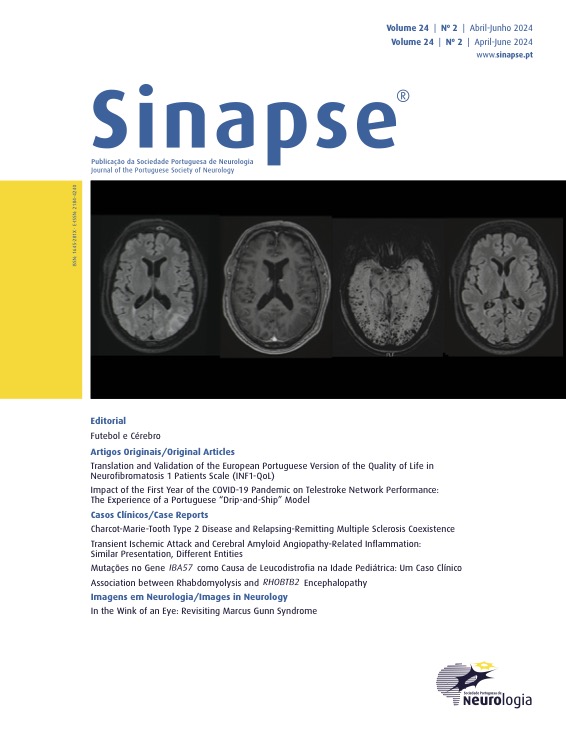Impacto do Primeiro Ano da Pandemia COVID-19 na Tele-Articulação Regional em Rede na Abordagem do AVC Isquémico Agudo: Experiência de um Modelo “Drip-and-Ship” Português
DOI:
https://doi.org/10.46531/sinapse/AO/230086/2024Palavras-chave:
COVID-19, Acidente Vascular Cerebral, Telemedicina, Transferência de DoentesResumo
Introdução: Embora escassos, os modelos organizacionais regionais para abordagem do acidente vascular cerebral (AVC) agudo recorrendo à telemedicina têm vindo a ser implementados em diversos países nas décadas mais recentes. A pandemia COVID-19 colocou à prova a rede de prestação de cuidados de saúde. O objetivo deste estudo foi avaliar o impacto do primeiro ano da pandemia COVID-19 no desempenho da Rede da Via Verde do AVC na região Centro de Portugal.Métodos: Estudo retrospetivo multicêntrico envolvendo os oito hospitais da Rede da Via Verde do AVC da região Centro de Portugal. O primeiro ano de pandemia COVID-19 (19/03/2020 a 18/03/2021) foi comparado com o período precedente, entre 01/01/2018 e 18/03/2020. Analisámos o número de teleconsultas, o número de doentes transferidos para tratamento endovascular, as métricas temporais de desempenho e o resultado funcional (avaliado através da modified Rankin Scale aos três meses).
Resultados: Observou-se um aumento de 8,2% no número de teleconsultas por dia na fase pandémica quando comparada com o período precedente e de 12,9% no número de doentes transferidos para trombectomia diariamente. Durante a pandemia, observou-se um aumento de 95,8 minutos no intervalo de tempo entre o início dos sintomas e a admissão no hospital primário (159,5 vs 255,3, p<0,01), de 18,5 minutos entre a admissão nos hospitais primário e terciário (205,6 vs 224,1, p=0,04). O intervalo entre a admissão no hospital terciário e a punção femoral reduziu 6,7 minutos (49,4 vs 42,7, p=0,08) e o intervalo entre a admissão no hospital terciário e a recanalização reduziu 24,2 minutos (101,9 vs 77,7, p<0,01). O resultado funcional aos 3 meses não foi afetado pela pandemia (OR 0,66 [95%CI 0,7-1,3], p=0,79).
Conclusão: Na pandemia, observaram-se resultados divergentes em diferentes domínios da cadeia de cuidados. Os resultados deste estudo realçam a relevância da existência de redes regionais para abordagem do AVC agudo bem estabelecidas, especialmente durante períodos colocam à prova a rede de prestação de cuidados de saúde.
Downloads
Referências
Menken M, Munsat TL, Toole JF. The global burden of disease study: implications for neurology. Arch Neurol. 2000;57:418-20. doi: 10.1001/archneur.57.3.418.
Feigin VL, Vos T, Nichols E, Owolabi MO, Carroll WM, Dichgans M, et al. The global burden of neurological disorders: translating evidence into policy. Lancet Neurol. 2020;19:255-65. doi: 10.1016/S1474-4422(19)30411-9.
Kuriakose D, Xiao Z. Pathophysiology and Treatment of Stroke: Present Status and Future Perspectives. Int J Mol Sci. 2020 Oct 15;21:7609. doi: 10.3390/ijms21207609.
GBD 2019 Stroke Collaborators. Global, regional, and national burden of stroke and its risk factors, 1990-2019: a systematic analysis for the Global Burden of Disease Study 2019. Lancet Neurol. 2021;20:795-820. doi: 10.1016/S1474-4422(21)00252-0.
Instituto Nacional de Estatística. Causas de morte 2021 [cited 2023 May 16].
Phipps MS, Cronin CA. Management of acute ischemic stroke. BMJ. 2020;368:l6983. doi: 10.1136/bmj.l6983.
Rabinstein AA. Update on Treatment of Acute Ischemic Stroke. Continuum. 2020;26:268-86. doi: 10.1212/CON.0000000000000840. PMID: 32224752.
Campbell BCV, Khatri P. Stroke. Lancet. 2020;396:129-42. doi: 10.1016/S0140-6736(20)31179-X.
Powers WJ, Rabinstein AA, Ackerson T, Adeoye OM, Bambakidis NC, Becker K, et al. Guidelines for the early management of patients with acute ischemic stroke: 2019 Update to the 2018 Guidelines for the Early Management of Acute Ischemic Stroke: A Guideline for Healthcare Professionals From the American Heart Association/American Stroke Association. Stroke. 2019;50(:e344-e418. doi: 10.1161/STR.0000000000000211. Erratum in: Stroke. 2019;50:e440-1.
Hess DC, Audebert HJ. The history and future of telestroke. Nat Rev Neurol. 2013;9:340-50. doi: 10.1038/nrneurol.2013.86.
González-Touya M, Stoyanova A, Urbanos-Garrido RM. COVID-19 and Unmet Healthcare Needs of Older People: Did Inequity Arise in Europe? Int J Environ Res Public Health. 2021;18:9177. doi: 10.3390/ijerph18179177.
Direcção-Geral da Saúde. Situação epidemiológica em Portugal distribuição dos casos em internamento. 2021. [cited 2021 March 19]. Available from: https://covid19.min-saude.pt/wp-content/uploads/2022/03/382_DGS_boletim_20210319_pdf-402kb.pdf
Romoli M, Eusebi P, Forlivesi S, Gentile M, Giammello F, Piccolo L, et al. Stroke network performance during the first COVID-19 pandemic stage: A meta-analysis based on stroke network models. Int J Stroke. 2021;16:771-83. doi: 10.1177/17474930211041202.
Sweid A, Jabbour P, Tjoumakaris S. Letter to the Editor: Incidence of Acute Ischemic Stroke and Rate of Mechanical Thrombectomy During the COVID-19 Pandemic in a Large Tertiary Care Telemedicine Network. World Neurosurg. 2020;140:491-2. doi: 10.1016/j.wneu.2020.06.053.
Fuentes B, Alonso de Leciñana M, García-Madrona S, Díaz-Otero F, Aguirre C, Calleja P, et al. Stroke Acute Management and Outcomes During the COVID-19 Outbreak: A Cohort Study From the Madrid Stroke Network. Stroke. 2021;52:552-62. doi: 10.1161/STROKEAHA.120.031769.
Hubert GJ, Santo G, Vanhooren G, Zvan B, Tur Campos S, Alasheev A, et al. Recommendations on telestroke in Europe. Eur Stroke J. 2019;4:101-9. doi: 10.1177/2396987318806718.
Downloads
Publicado
Como Citar
Edição
Secção
Licença
Direitos de Autor (c) 2024 Inês V. Carvalho, Francisco Millet Barros, Carolina Sousa Fernandes, João Sousa, Ana Isabel Rodrigues, Pedro Faustino, Emanuel Martins, Diogo Damas, Catarina Bernardes, Carolina Teles, Telma Alves, Carolina Martins, Rita Ramalho, Carolina Maia, Henrique Queirós, Elisa Viegas, Filipa Costa Sousa, Inês Pinheiro, Laura Baptista, Ana Patrícia Gomes, Fábia Cruz, Jéssica Fidalgo, André Carvalho, Carla Nunes, Cristina Machado, Bruno Rodrigues, Luciano Almendra, Fernando Silva, César Nunes, Ricardo Veiga, Dulcídia Sá, Emanuel Araújo, Eugénia André, Fátima Paiva, João Correia, Abílio Gonçalves, Ana Gomes, João Sargento-Freitas, Egídio Machado, Gustavo C. Santo

Este trabalho encontra-se publicado com a Creative Commons Atribuição-NãoComercial 4.0.








